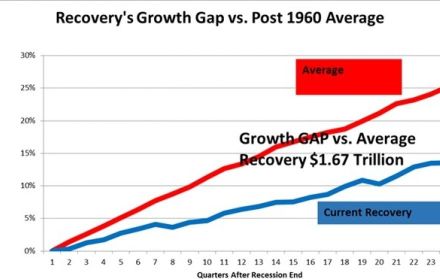Losing Ground In Flyover America, Part 2
In fact, the combination of pumping-up inflation toward 2% and hammering-down interest rates to the so-called zero bound is economically lethal. The former destroys the purchasing power of main street wages while the latter strip mines capital from business and channels it into Wall Street financial engineering and the inflation of stock prices.
In the case of the 2% inflation target, even if it was good for the general economy, which it most assuredly is not, it’s a horrible curse on flyover America. That’s because its nominal pay levels are set on the margin by labor costs in the export factories of China and the EM and the service sector outsourcing shops in India and its imitators.
Accordingly, wage earners actually need zero or even negative CPI’s to maximize the value of pay envelopes constrained by global competition. Indeed, in a world where the global labor market is deflating wage levels, the last thing main street needs is a central bank fanatically seeking to pump up the cost of living.
So why do the geniuses domiciled in the Eccles Building not see something that obvious?
The short answer is they are trapped in a 50-year old intellectual time warp that presumes that the US economy is more or less a closed system. Call it the Keynesian bathtub theory of macroeconomics and you have succinctly described the primitive architecture of the thing.
According to this fossilized worldview, monetary policy must drive interest rates ever lower in order to elicit more borrowing and aggregate spending. And then authorities must rinse and repeat this monetary “stimulus” until the bathtub of “potential GDP” is filled up to the brim.
Moreover, as the economy moves close to the economic bathtub’s brim or full employment GDP, labor allegedly becomes scarcer, thereby causing employers to bid up wage rates. Indeed, at full employment and 2% inflation wages will purportedly rise much faster than consumer prices, permitting real wage rates to rise and living standards to increase.
Except it doesn’t remotely work that way because the US economy is blessed with a decent measure of free trade in goods and services and virtually no restrictions on the flow of capital and short-term financial assets. That is, the Fed can’t fill up the economic bathtub with aggregate demand because it functions in a radically open system where incremental demand is as likely to be satisfied by off-shore goods and services as by domestic production.
This leakage through the bathtub’s side portals into the global economy, in turn, means that the Fed’s 2% inflation and full employment quest can’t cause domestic wage rates to rev-up, either. Incremental demands for labor hours, on the margin, are as likely to be met from the rice paddies of China as the purportedly diminishing cue of idle domestic workers.
Indeed, there has never been a theory so wrong-headed. And yet the financial commentariat, which embraces the Fed’s misbegotten bathtub economics model hook, line and sinker, disdains Donald Trump because his economic ideas are allegedly so primitive!
The irony of the matter is especially ripe. Even as the Fed leans harder into its misbegotten inflation campaign it is drastically mis-measuring its target, meaning that flyover American is getting an extra dose of punishment.
On the one hand, real inflation where main street households live has been clocking in at over 3% for most of this century. At the same time, the Fed’s faulty measuring stick has led it to keep interest pinned to the zero bound for 89 straight months, thereby fueling the gambling spree in the Wall Street casino. The baleful consequence is that more and more capital has been diverted to financial engineering rather than equipping main street workers with productive capital equipment.
As we indicated in Part 1, even the Fed’s preferred inflation measuring stick——the PCE deflator less food and energy—has risen at a 1.7% rate for the last 16 years and 1.5% during the 6 years. Yet while it obsesses about a trivial miss that can not be meaningful in the context of an open economy, it fails to note that actual main street inflation—led by the four horseman of food, energy, medical and housing—–has been running at 3.1% per annum since the turn of the century.
After 16 years the annual gap, of course, has ballooned into a chasm. As shown in the graph, the consumer price level faced by flyover America is now actually 35% higher than what the Fed’s yardstick shows to the case.
Stated differently, main street households are not whooping up the spending storm that our monetary central planners have ordained because they don’t have the loot. Their real purchasing power has been tapped out.
To be sure, real growth and prosperity stems from the supply-side ingredients of labor, enterprise, capital and production, not the hoary myth that consumer spending is the fount of wealth. Still, the Fed has been consistently and almost comically wrong in its GDP growth projections because the expected surge in wages and consumer spending hasn’t happened.


